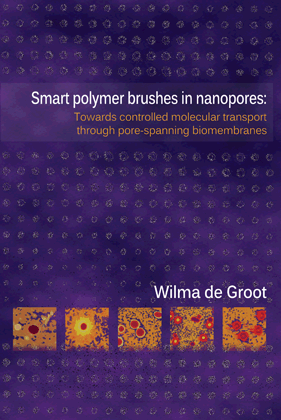
The aim of this thesis was the development of stimulus responsive polymer brush structures as micropore switches for molecular screening. This was achieved by grafting pH-responsive poly(methacrylic acid) (PMAA) brushes from nanoporous platforms that were then integrated in functional assays for membrane proteins. Several properties of the smart PMAA brush contributed to the functionality of such protein assays. Controlled transport of ions and molecules through nanopores, support of pore-spanning artificial lipid bilayers and positioning of membrane proteins over the pores were achieved with the explored PMAA-brush functionalized platforms.
Chapter 1 provides a short introduction to and motivation for the control of molecular transport in bioassays with macromolecular nanotechnology
Chapter 2 contain a literature overview of smart polymer brushes in nanopores for controlled molecular gating is discussed, including theory, synthesis and characterization of polymer brushes. In addition, examples of stimulus responsive polymer brushes applications in surface functionalization and control of transport across pores are described.
As additional review of the literature background for the work presented in this thesis, an overview on pore-spanning lipid bilayers for functional assays of membrane proteins is presented in Chapter 3. The role of membrane proteins as drug targets is introduced and the current limitations in the development of such assays are discussed. The formation and characterization of artificial lipid bilayers and the integration of membrane proteins in the biomembranes is also part of this chapter. Specific examples of the relevance of the polymer support for artificial lipid bilayers are mentioned.
As part of the design of the modification of nanoporous platforms with polymer brushes, PMAA brushes were grafted from flat silicon surfaces using surface-initiated atom transfer radical polymerization (SI-ATRP).
Chapter 4 describes growth kinetics of the pH-responsive polymer layers were investigated in mixtures of water and methanol with different ratios. The pH-induced swelling and collapse of the brush were characterized by in situ ellipsometry, and showed a fast and reversible switching of the PMAA layers with swelling factors that increased by decreasing the methanol content of the atom transfer radical polymerization mixture. Fourier transform infrared (FTIR) spectra recorded in titration experiments indicated that the effective pKa of the PMAA films were shifted to the value of 6.5 ± 0.2 from the bulk pKa value of PMAA. The shift is due to ion confinement effects in the dense brush, and brings the conformational switching of PMAA brushes closer to physiological conditions. This is relevant for biologically oriented applications in miniaturized devices with rapid response times.
In Chapter 5 the PMAA brush functionalization and characterization of nanoporous platforms with wells (dead-end pores) or channels (pores through) is described. The brushes were synthesized by SI-ATRP in a mixture of water and methanol (1:1 by volume) to improve the wettability of the pores. The PMAA brush growth and its pH-sensitive behavior on the nanoporous platforms were confirmed by scanning electron microscopy (SEM), atomic force microscopy (AFM) and FTIR spectroscopy. AFM imaging was further used to observe the swelling of the PMAA brush selectively inside the wells upon varying the pH of the liquid environment from 4 to 8. AFM images showed open nanopores at pH 4 and closed ones at pH 8. Platforms with nanochannels were functionalized with PMAA brushes and investigated by cyclic voltammetry at varied pH values. The functionalized pores had higher electrical resistance when the brush was in a neutral state and lower resistance when the brush was charged. The results of these measurements, combined with diffusion experiments using a fluorescent dye to investigate mechanical gating, demonstrated the controlled transport of ions and small molecules across the pores. All the results presented in this chapter rationalize the use of nanoporous platforms functionalized with PMAA brushes for controlled gating applications, for example as electrochemical (bio)sensors or nanoscale valves.
In Chapter 6, a description is provided discussing functionalization of silicon-based nanopore array chips functionalized with PMAA brush, which were used as supports for pore-spanning lipid bilayers. The formation of the suspended artificial lipid bilayers was achieved by spontaneous liposome rupture and fusion. Enhanced membrane resistance as determined by electrochemical impedance spectroscopy (EIS) and free diffusion of dyed lipids observed as fluorescence recovery after photobleaching (FRAP) confirmed the presence of the lipid bilayer. Besides for the support of the lipid bilayer, the PMAA chains were functionalized with nitrilotriacetic acid (NTA) for immobilization of His-tagged membrane proteins. The localization of the membrane proteins near the pore edges and their integration in the pore-spanning lipid bilayer was imaged by fluorescence microscopy. It was also demonstrated that the protein density could be varied in a wide range without impairing the formation of the lipid bilayer. Although improvements are needed for the electrochemical measurements of membrane protein activity, yet the potential application of the integrated platform for ion channel protein assays is demonstrated.
An outlook with a discussion of the current limitations to design screening devices for membrane proteins is in Chapter 7. Future developments of the work presented in this thesis include: addressing the switch on/off of individual pores for controlled transport across selected pores; analyzing the transport of ions and low-molecular-weight drug candidates per single nanopore; and test the universal applicability of the designed assay platforms by integrating different types of membrane proteins.